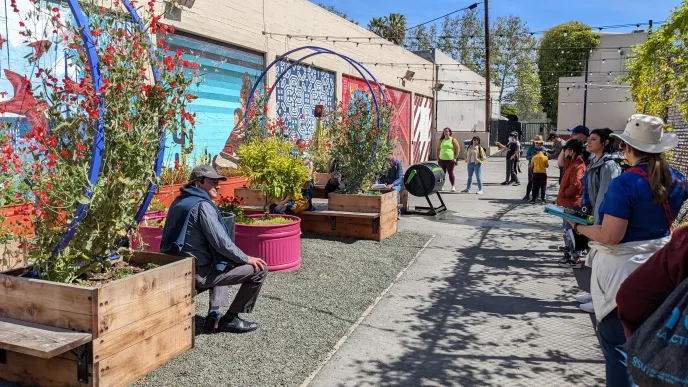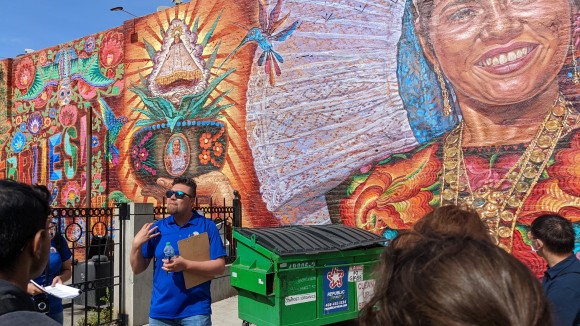Public Art as Resistance in San José: A Walking Tour

Participants at the April 2022 tour listen to Judi Heher, tour guide (Urban Geography), at the SoFA Pocket Park murals. Image courtesy of Katherine D. Harris.
Public art sometimes becomes so part of the landscape that its existence blends in as part of the buildings that we pass by, the wall that is's suddenly no longer blank, or the entryway that's no longer empty. Emboldening people to see, understand, and become awash in the history and purpose of public art means doing more than pointing out its existence. It means constructing a narrative that will center the stories and histories of the art, the urban environment in which it resides, and the viewers. The City of San José is typically known as the “Capital of Silicon Valley,” but there’s also a vibrant relationship between the urban environment and the arts in general—and San José State University (SJSU) is right in the middle of all of the action. Myself and Dr. Alena Sauzade, as co-directors of the Public Art as Resistance in San José project, set out to honor and highlight the rich environment of downtown San José and the abundance of public art peppered throughout the downtown city streets, with more than 300 pieces in a five-mile radius.
Engaging community partners, faculty experts, and students, we developed a walking tour of twelve works of public art in downtown San José that focus on acts of resistance in a variety of ways. With the generous support of a Humanities for All Quick Grant from the California Humanities Council, we were able to begin the first phase of this larger, multi-year collaborative research and mapping project aimed at connecting faculty and students at SJSU with local arts organizations, community activists, and historical archives to explore how San José residents and invited artists create, utilize, and activate public art spaces to become sites of resistance and empowerment. The aim of this project was not to create an all-encompassing public art map for the city—an undertaking that is nearly impossible in such a fast changing, dynamic place—but to focus deliberately and specifically on one aspect of San José’s public arts landscape: the exploration of monuments, memorials and murals as sites of resistance. To that end, we built an online presence, partnered with several arts organizations including the San José Museum of Art and San José Walls, brought together an interdisciplinary faculty team, and collaborated with the creator of a free mobile app—all to establish several different pathways into the project that took into consideration physical mobility, internet accessibility, and in-person safety. It’s not enough to look at only the artwork—we wanted participants to consider place, space, and access as well.

The first seeds of this research project began in Fall 2021, when SJSU undergraduate students in Art 174, Museum and Gallery Operations, worked independently to research and write a nascent history of resistance as it intersects with San José’s public art. Students contributed mini-essays on some individual artwork web pages while faculty experts in museum studies, art history, geography, and humanities filled in other aspects of the artwork’s significance by speaking with local arts organizations to learn about their processes for the creation of public art projects and considered the many ways in which resistance can intersect with public art production. The artist’s voice was incorporated, where available, by embedding videos and offering a list of resources on each artwork web page. The intention was to aggregate as much existing information as possible alongside student and faculty research.
As the team amassed the content, we learned from our community partners and the artists’ themselves about the importance of the placement of their public art. Conversations with our community partners, Local Color SJ, Movimiento de Arte y Cultura Latino Americana (MACLA), San José Walls, The San José Museum of Art, and the San José Museum of Quilts & Textiles, revealed the extent to which these organizations have built resistance into all aspects of the public art creation in San José through their implementation of Diversity, Equity, Inclusion, Accessibility (DEIA) criteria in all aspects of the process, from writing and distributing calls for art to selection and implementation. Moreover, we heard about how organizations seek to support and empower artists through fair compensation and acknowledgment of artist labor in the proposal and selection process and their deliberate and focused processes of soliciting arts proposals from all of the diverse communities that make up San José. The organizations equally work to employ and engage artists and bring them together with communities to create shared, collaborative experiences of art making. The collaborative efforts among all parties helped to construct the project’s ethos: that monuments, public art, and cultural maps stand as public acknowledgments to people and events woven into community and national narratives. The art complements the historical perspectives that are taught within the formal education system to create a common origin story for a unified society.
The tour begins intentionally at SJSU to bring outside constituents and students alike to the campus to experience its beauty beyond the invisible garden walls of the university’s borders. At the outset of each tour, we enacted a form of resistance ourselves by asking participants to acknowledge and honor the Muwekma Ohlone Area Land on which SJSU and downtown San José reside. We begin at the Arch of Dignity, Equality, and Justice, in tribute to activist Cesar Chavez by artist Judith Baca (commissioned by SJSU in 2008), placed adjacent to the Student Union building and off of an important pedestrian passageway. The Arch is designed to be circumambulated and entered. For Baca, as students and visitors to SJSU move through the arch and learn of Chavez and his work, their own bodies are symbolically transformed from witnesses to activists. This transformation is key to the success of this tour as we wander through downtown San José to eleven other works of public art.

During Spring 2022, the project supported activities around downtown San José (free and open to the public) including three in-person, guided walking tours of public art; a self-guided tour (using an artistically-designed map & Linktree); a culminating panel discussion about the art of resistance and resistant public art, monuments, and memorials; and an exhibit at the downtown San José Hammer Theatre curated from a social media hashtag campaign #SJResistArt that invited participants to define resistance in public art for themselves.
While this project specifically focuses on twelve works of public art in downtown San José, its central proposition is one that is relevant far beyond this city—to map, visit, and learn the histories of public art works is in itself an act of resistance. To consider the living histories and stories of communities, one must go beyond the dominant and established narrative and outside the confines of research materials. Instead, the exploration of public art has to be done through the activation of one’s body, armed with a map and a set of directions, the visitor sets off to experience and explore, to engage the city and to see it as it is at a specific moment in time.
Dr. Katherine D. Harris is Director of Public Programming for the College of Humanities and the Arts and the architect of the H&A in Action initiative at San José State University.